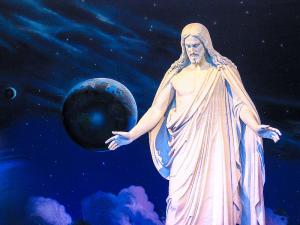When April comes to Independence, Missouri, Latter Day Saints will go to conference. Community of Christ members will go to conference. Latter-day Saints will go to conference. Remnant saints will go to conference. Church of Christ (Temple Lot) members will go to conference. Saints who are first-generation Americans from Samoa will go to conference. Saints who have flown from Nigeria to Missouri will go to conference. And saints from dozens of other nations will go to conference. Members of the counter-cult movement will go to conference, too. Even the radical Fred Phelps of the tiny Topeka-based Westboro Baptist Church may go to conference (though no one is inviting him). In April, the millennial ground zero for Joseph Smith’s projected New Jerusalem, better than any place on earth, will become a platform for showcasing the aspirations, issues, and disagreements that shape contemporary Mormon churches.
Take for instance the small Remnant Church of Jesus Christ of Latter Day Saints. Founded in 2000 from traditionalists who left the then RLDS church, the Remnant Church will hold its annual General Conference in Independence from April 3-7. Led by a great-great-grandson of Joseph Smith, Jr., Frederic Larsen, the Remnant Church has amazingly large ambitions that its 2,000 members will discuss at conference. (All baptized members of the Remnant church may attend and vote at their General Conference.) In the fall of 2012, the Remnant Church First Presidency announced a five-year plan to build a temple in Jackson County, Missouri. At the April conference, members will explore the possible ministries and uses of such a temple in Zion. Remnant Church members will also discuss increased missionary outreach and two proposed communities where church members will live with one another in a neighborhood association. One of the aforementioned communities, named “Bountiful” after a land in the Book of Mormon, already has five families in residence. And, the Remnant Church also hopes to build an elementary school and an assisted-care senior center in Jackson County, Missouri. [1] This “bricks and mortar” plan for Zion repristinates the traditional, early 20th century RLDS vision for the kingdom of God on earth. Here, Zion represents a lighthouse to the world, as well as a city of refuge. The implementation of this vision of Zion will undoubtedly strain and challenge the resources of the Remnant Church. At the April conference, the Remnant Church will stand at a turning point for its future as a body.
For the saints who belong to the Community of Christ (the RLDS church), Zion is a “leaven” in the world that seeks for shalom—peace and justice. While this Zion is not tied to building literal communal groups connected to geography in Missouri, it symbolically anchors itself in a 300-foot spiral temple in Independence that serves as a center for worship, education, and church administration. In that temple as well as an adjoining auditorium, 2,800 Community of Christ delegates from around the world will meet in a triennial “World Conference” to legislate policies, approve ordinations of leaders, and worship together. Immediately following the World Conference, American members of the Community of Christ will meet for a U.S. National Conference. There, they will consider how Zion, as shalom, is expressed through human sexuality.
From April 19-21, 1500 American delegates, elected by their local jurisdictions, will consider whether or not to bless same-sex marriages and unions in the USA. Delegates will also vote on whether or not their church within the bounds of the USA will ordain LGBT individuals who maintain monogamous, committed relationships. In grueling all-day sessions that run from 7 a.m. to 7 p.m. (plus an evening worship service), Community of Christ delegates will vote on issues on a sliding scale of 1 to 5, with 5 being full support for an issue and 1 being fully opposed to a question. To pass, a question will need a super majority, or two-thirds of the people voting as a 4 or a 5. Similarly, for an issue to be defeated, two-thirds must vote with a 1 or 2. Failure to reach either one decision or the other will result in a decision, too: “We’re still talking.” The April conference will be a massive experiment in consensus building or “common consent,” to use a nineteenth-century Latter Day Saint term.
The Community of Christ delegates that I have met (and I am also a delegate) seem both hopeful and nervous for the upcoming conference. Regardless of the outcome, many worry that a small schism might happen in the US church, though no one anticipates a large one. Those who support same-sex marriage and LGBT ordinations worry what will happen if a stalemate is achieved. Will young adults leave the church en masse? Will LGBT individuals leave? Will people really continue talking? The stakes are very high and very personal for many. The delegates from my mission center in New England all have relatives or congregation members who identify as LGBT. At the crossroads of Zion, the Community of Christ itself faces a proverbial fork in the road.
And then there are the former saints who will be at the conferences. Literally standing at the crossroads of Walnut and River Roads, the very heart of the temple tract of land dedicated by Joseph Smith, Jr. in 1831, former Latter Day Saints will gather in April to hand out literature. As members of the counter-cult movement, these former saints will politely witness to Community of Christ delegates about a fundamentalist, evangelical Jesus and a deceiver named Joseph Smith. However self assured these counter-cult members act, they stand at an identity crisis this conference season. The ex-RLDS counter cult produces literature that critiques beliefs that the Community of Christ has not espoused for decades. [2] In addition, many Community of Christ members sympathize with some of the counter cult’s critiques of Joseph Smith as a flawed individual. (Though, they would differ in the meaning of those same critiques for church affiliation.) Counter-cult members whom I have met are aware that they face a crisis about their audience and content. Do they hand out antiquated literature about 1970s RLDS beliefs to Community of Christ members; do they target only former RLDS, like the Remnant saints; or do they target conservative Community of Christ members who are dissatisfied with talk of LGBT inclusion? If they do the latter, why not also picket their local United Church of Christ? Fred Phelps, the Topeka-based pastor infamous for turning every human tragedy into a message from God about gays, is anticipated to show up to protest at the crossroads of Zion. If Phelps or members of his church make an appearance, as some predict, counter cult activists will be at pains to separate their version of evangelical fundamentalism from Phelps’ much more extreme version.
Finally, on the corner of River and Walnut, there may be young, smiling LDS elders and sister missionaries ready to talk to passersby. While the Community of Christ Temple and Auditorium flanks the River-Walnut intersection, the LDS Visitor Center in Independence does, too. Of course, the biannual LDS General Conference from Salt Lake City will be broadcast on April 6 and 7 to LDS meeting houses across the world. An LDS stake center adjacent to the Independence Visitor Center will broadcast the conference, and many local LDS will view the proceedings from there. Later in the month, though, LDS missionaries will be sure to be out and about when Community of Christ delegates come to conference. For instance, during the 2010 conference season, I witnessed a young LDS elder whip out his guitar and serenade the delegates who were walking back and forth from the Community of Christ Temple to the Community of Christ Auditorium. Saints from a dozen nations heard the missionary and some stopped to talk with him and his companions. The missionary’s music was a nice gesture, but it also sent an ambiguous message. I remember hearing the missionary sing, “Softly and Tenderly, Jesus is Calling….Calling, Oh, Sinner, Come Home.” I was not sure if the missionary intended that message for himself, me, the counter cult folks, or all of us. Nonetheless, this scene encapsulated for me what Independence becomes during the April conference season: a living performance of the diversity of contemporary Mormonism. Saints from Kenya, saints from Kansas, saints from competing churches, and ex-saints politely talked, walked, and sang past each other as they traversed the ground once dedicated for the city New Jerusalem. From out of one, many.
When April comes to Independence, saints will go to separate conferences, and this attests to the fissiparous nature of Joseph Smith’s Restoration movement. Seen another way, saints will go to different conferences, and this reveals an amazing amount of cultural creativity from the diverse peoples who still try to realize Smith’s many visions for Zion. While there will be millions of saints who will watch the proceedings of an April conference broadcast from Salt Lake City, the religious, political, and international diversity of Mormonism will be most abundantly present a few weeks later at a crossroads 1000 miles away.
[1] John Hamer, “Remnant Church Announces Temple Plans,” Saints Herald: A Community of Christ Blog, 14 February 2013, http://saintsherald.com/2013/02/14/remnant-church-announces-temple-plans/ ; Bob Ostrander, interview with author, 6 March 2013.
[2] For instance, see Carol Hansen, Reorganized Latter Day Saint Church: Is It Christian? (Independence, Missouri: Refiner’s Fire Ministries, 2003). Hansen, a former RLDS member, attends a fundamentalist Baptist congregation and has led efforts to evangelize RLDS members since the 1970s.











